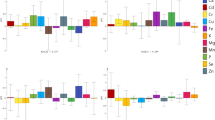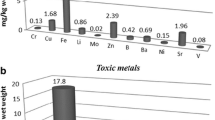Abstract
The quantity of some essential and non-essential elements of wild edible mushroom samples collected from Tunceli Province of Turkey was determined by using flame and electrothermal atomic absorption spectrometer after microwave digestion. The method accuracy was corrected using standard reference material (NIST SRM 1547-Peach Leaves). The essential element concentrations of analyzed mushroom samples were determined in the range of 0.036–0.563 mg kg−1 for calcium, 1.28–2.55 mg kg−1 for magnesium, 0.054–0.188 mg kg−1 for sodium, 1.00–4.57 mg kg−1 for copper, 212–480 mg kg−1 for iron, and 75–151 mg kg−1 for zinc but cobalt and chromium were not detected. Based on results, there were statistically significant differences between the element contents of analyzed mushroom species. Consequently, according to this study results, the weekly intake and target hazard quotient values of the elements show that the consumption of these mushrooms does not threaten human health.

Graphical abstract


Similar content being viewed by others
References
Tong H, Xia F, Feng K, Sun G, Gao X, Sun L, Jiang R, Tian D, Sun X (2009) Structural characterization and in vitro antitumor activity of a novel polysaccharide isolated from the fruiting bodies of Pleurotus ostreatus. Bioresour Technol 100(4):1682–1686. https://doi.org/10.1016/j.biortech.2008.09.004
Turkoğlu A, Duru ME, Mercan N, Kivrak I, Gezer K (2007) Antioxidant and antimicrobial activities of Laetiporus sulphureus (Bull.) Murrill. Food Chem 101(1):267–273. https://doi.org/10.1016/j.foodchem.2006.01.025
Moradali MF, Mostafavi H, Ghods S, Hedjaroude GA (2007) Immunomodulating and anticancer agents in the realm of macromycetes fungi (macrofungi). Int Immunopharmacol 7(6):701–724. https://doi.org/10.1016/j.intimp.2007.01.008
Gern RMM, Wisbeck E, Rampinelli JR, Ninow JL, Furlan SA (2008) Alternative medium for production of Pleurotus ostreatus biomass and potential antitumor polysaccharides. Bioresour Technol 99:76–82. https://doi.org/10.1016/j.biortech.2006.11.059
Chen S, Oh SR, Phung S, Hur G, Ye JJ, Kwok SL, Shrode GE, Belury M, Adams LS, Williams D (2006) Anti-aromatase activity of phytochemicals in white button mushrooms (Agaricus bisporus). Cancer Res 66(24):12026–12034
Zhang M, Cui SW, Cheung PCK, Wang Q (2007) Antitumor polysaccharides from mushrooms: a review on their isolation process, structural characteristics and antitumor activity. Trends Food Sci Technol 18(1):4–19
Jeong SC, Jeong YT, Yang BK, Islam R, Koyyalamudi SR, Pang G, Cho KY, Song CH (2010) White button mushroom (Agaricus bisporus) lowers blood glucose and cholesterol levels in diabetic and hypercholesterolemic rats. Nutr Res 30:49–56
Kalac P (2009) Chemical composition and nutritional value of European species of wild growing mushrooms: a review. Food Chem 113(1):9–16
Ferreira ICFR, Barros L, Abreu RMV (2009) Antioxidants in wild mushrooms. Curr Med Chem 16(12):1543–1560
Purkayastha RP, Chandra A (1985) Manual of Indian Edible mushrooms. Today & Tomorrow’s Printers and Publishers, New Delhi, pp 226–244
Sanmee R, Dell B, Lumyong P, Izumori K, Lumyong S (2003) Nutritive value of popular wild edible mushrooms from northern Thailand. Food Chem 84(4):527–532
Manzi P, Marconi S, Aguzzi A, Pizzoferrato L (2004) Commercial mushrooms: nutritional quality and effect of cooking. Food Chem 84:201–206
Agrahar-Murugkar D, Subbulakshmi G (2005) Nutritional value of edible wild mushrooms collected from the Khasi hills of Meghalaya. Food Chem 89(4):599–603
Pereira E, Barros L, Martins ARL, Ferreira ICFR (2012) Towards chemical and nutritional inventory of Portuguese wild edible mushrooms in different habitats. Food Chem 130(2):394–403
Reis FS, Barros L, Martins A, Ferreira ICFR (2012) Chemical composition and nutritional value of the most widely appreciated cultivated mushrooms: an inter-species comparative study. Food Chem Toxicol 50(2):191–197
Obodai M, Ferreira ICFR, Fernandes A, Barros L, Mensah DLN, Dzomeku M, Urben AF, Prempeh J, Takli RK (2014) Evaluation of the chemical and antioxidant properties of wild and cultivated mushrooms of Ghana. Molecules 19(12):19532–19548
Gebrelibanos M, Megersa N, Taddesse AM (2016) Levels of essential and non-essential metals in edible mushrooms cultivated in Haramaya, Ethiopia. Int J Food Contam 3(2):1–12
Baba H, Ergün N, Özcubukcu S (2012) Antakya (Hatay)’dan toplanan bazı makrofungus türlerinde ağır metal birikimi ve mineral tayini. BİBAD 5(1):5–6
Manzi P, Aguzzi A, Pizzoferrato L (2001) Nutritional value of mushrooms widely consumed in Italy. Food Chem 73:321–325
Meng F, Zhou B, Lin R, Jia L, Liu X, Deng P, Fan K, Wang G, Wang L, Zhang J (2010) Extraction optimization and in vivo antioxidant activities of exopolysaccharide by Morchella esculenta SO-0. Bioresour Technol 101:4564–4569
Oke F, Aslim B (2011) Protective effect of two edible mushrooms against oxidative cell damage and their phenolic composition. Food Chem 128:613–619
Alam N, Yoon KN, Lee JS, Cho HJ, Lee TS (2012) Consequence of the antioxidant activities and tyrosinase inhibitory effects of various extracts from the fruiting bodies of Pleurotus ferulae. Saudi J Biol Sci 19:111–118
Giri S, Biswas G, Pradhan P, Mandal SC, Acharya K (2012) Antimicrobial activities of basidiocarps of wild edible mushrooms of west Bengal, India. Int J Pharm Tech Res 4(4):1554–1560
Badshah H, Qureshi RA, Khan J, Ullah F, Fahad S, Ullah F, Khan AM, Hussain I, Khan N (2012) Pharmacological screening of Morchella esculenta (L) Pers., Calvatia gigantea (Batsch ex Pers.) Lloyd and Astraeus hygrometricus Pers., mushroom collected from South Waziristan (FATA.). J Med Plants Res 6(10):1853–1859
Heleno SA, Stajkovic D, Barros L, Galamoclija J, Sokovic M, Martins A, Queiroz MJ, Ferreira ICFRA (2013) Comparative study of chemical composition, antioxidant and antimicrobial properties of Morchella esculenta (L.) Pers. From Portugal and Serbia. Food Res Int 51:236–243
Li S, Shah NP (2014) Antioxidant and antibacterial activities of sulphated polysaccharides from Pleurotus eryngii and Streptococcus thermophilus ASCC 1275. Food Chem 165:262–270
Ren L, Hemar Y, Perera CO, Lewis G, Krissansen GW, Buchanan PK (2014) Antibacterial and antioxidant activities of aqueous extracts of eight edible mushrooms. Bioact Carbohydr Diet Fibre 3:41–51
Woldegiorgis AZ, Abate D, Haki GD, Ziegler GR (2014) Antioxidant property of edible mushrooms collected from Ethiopia. Food Chem 157:30–36
Elmastas M, Turkekul I, Ozturk L, Gulcin I, Isildak O, Aboul-Enein HY (2006) Antioxidant activity of two wild edible mushrooms (Morchella vulgaris and Morchella esculanta) from North Turkey. Comb Chem High Throughput Screen 9:443–448
WHO (1993) Evaluation of certain food additives and contaminants. Technical Report No. 837. World Health Organization, Genewa
USEPA. USEPA Regional Screening Level (RSL) Summary Table: November 2011
JECFA—Joint Expert Committee for Food Additives (2003) Summary and Conclusions of the 61st Meeting of the Joint FAO/WHO Expert Committee on Food Additives (JECFA). JECFA/61/SC. Rome, Italy
Ihugba UA, Nwoko CO, Tony-Njoku FR, Ojiaku AA, Izunobi L (2018) Heavy metal determination and health risk assessment of oyster mushroom Pleurotus tuberregium (Fr.) Singer, collected from selected markets in Imo State. Nigeria. Am J Environ Protect 6(1):22–27
US EPA (Environmental Protection Agency) (2002) A review of the reference dose and reference concentration processes. Risk Assessment Forum, Washington, DC; EPA/630/P-02/002F. Available online at http://www.epa.gov/ncea/raf
Woldegiorgis AZ, Abate D, Haki GD, Ziegler GR (2015) Major, minor and toxic minerals and anti-nutrients composition in edible mushrooms collected from Ethiopia. J Food Process Technol 6(3):2–8
Gast CH, Jansen E, Bierling J, Haanstra L (1988) Heavy metals in mushrooms and their relationship with soil characteristics. Chemosphere 17(4):789–799
Kalac P, Burda J, Staskova I (1991) Concentrations of lead, cadmium, mercury, and copper in mushrooms in the vicinity of a lead smelter. Sci Total Environ 105:109–119
Cocchi L, Vescovi L, Petrini LE, Petrini O (2006) Heavy metals in edible mushrooms in Italy. Food Chem 98:277–284
Tuzen M, Sesli E, Soylak M (2007) Trace element levels of mushroom species from East Black Sea region of Turkey. Food Control 18:806–810
Gursoy N, Sarikurkcu C, Cengiz M, Solak MH (2009) Antioxidant activities, metal contents, total phenolics and flavonoids of seven Morchella species. Food Chem Toxicol 47:2381–2388
Isildak Ö, Turkekul I, Elmastas M, Tuzen M (2004) Analysis of heavy metals in some wild-grown edible mushrooms from the middle black sea region, Turkey. Food Chem 86:547–552
Liu H, Zhang J, Li T, Shi Y, Wang Y (2012) Mineral element levels in wild edible mushrooms from Yunnan, China. Biol Trace Elem Res 147:341–345
Li T, Wang Y, Zhang J, Zhao Y, Liu H (2011) Trace element content of Boletus tomentipes mushroom collected fromYunnan, China. Food Chem 127:1828–1830
Gençcelep H, Uzun Y, Tunçtürk Y, Demirel K (2009) Determination of mineral contents of wild-grown edible mushrooms. Food Chem 113:1033–1036
Sarikurkcu C, Copur M, Yildiz D, Akata I (2011) Metal concentration of wild edible mushrooms in Soguksu National Park in Turkey. Food Chem 128:731–734
Kosanic M, Rankovic B, Rancic A, Stanojkovic T (2016) Evaluation of metal concentration and antioxidant, antimicrobial, and anticancer potentials of two edible mushrooms Lactarius deliciosus and Macrolepiota procera. J Food Drug Anal 24:477–484
Vimala R, Das N (2009) Biosorption of cadmium (II) and lead (II) from aqueous solutions using mushrooms: a comparative study. J Hazard Mater 168:376–382
Ivanić M, Fiket Z, Medunić G, Turk MF, Marović G, Senčar J, Kniewald G (2019) Multi-element composition of soil, mosses and mushrooms and assessment of natural and artificial radioactivity of a pristine temperate rainforest system (Slavonia, Croatia). Ecotoxicol Environ Saf 137:265–271
Falandysz J, Drewnowska M, Chudzińska M, Barałkiewicz D (2017) Accumulation and distribution of metallic elements and metalloids in edible Amanita fulva mushrooms. Ecotoxicol Environ Saf 137:265–271
Šíma J, Vondruška J, Svoboda L, Šeda M, Rokos L (2019) The accumulation of risk and essential elements in edible mushrooms Chlorophyllum rhacodes, Suillus grevillei, Imleria badia, and Xerocomellus chrysenteron growing in the Czech Republic. Chem Biodivers 16:e1800478
Chen XH, Zhou HB, Qiu GZ (2009) Analysis of several heavy metals in wild edible mushrooms from regions of China. Bull Environ Contam Toxicol 83(2):280–285
Baldrian P, Gabriel J (2003) Lignocellulose degradation by Pleurotus ostreatus in the presence of cadmium. FEMS Microbiol Lett 220(2):235–240
Saba M, Falandysz J, Nnorom IC (2016) Mercury bioaccumulation by Suillus bovinus mushroom and probable dietary intake with the mushroom meal. Environ Sci Pollut Res 23:14549–14559
Acknowledgments
We thank Abdunnasir Yildiz, Professor (Department of Biology, Faculty of Science, Dicle University, Diyarbakir, Turkey) for the diagnosis of the mushroom species.
Conflict of interest
The authors declare that they have no conflict of interest.
Author information
Authors and Affiliations
Corresponding author
Ethics declarations
This study does not involve human or animal subjects.
Additional information
Publisher’s Note
Springer Nature remains neutral with regard to jurisdictional claims in published maps and institutional affiliations.
Rights and permissions
About this article
Cite this article
Alp, H., Ince, M., Ince, O.K. et al. Evaluation the Weekly Intake of Some Wild Edible Indigenous Mushrooms Collected in Different Regions in Tunceli, Turkey. Biol Trace Elem Res 195, 239–249 (2020). https://doi.org/10.1007/s12011-019-01814-3
Received:
Accepted:
Published:
Issue Date:
DOI: https://doi.org/10.1007/s12011-019-01814-3




